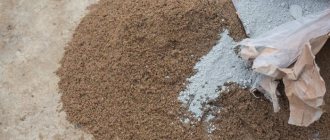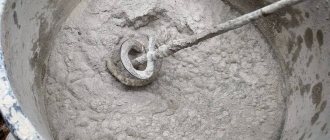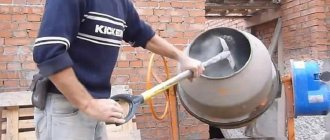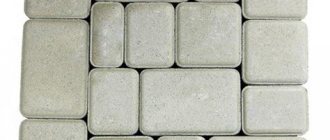Most people who want to build their own country house, cottage or garage are wondering about the price of the project. Affordable building materials will help you save. One of these is economical concrete made from screenings with sufficient mechanical parameters. Concrete is most widely used in the construction industry. Let's get acquainted with what is required for the production of concrete from screenings and cement proportions, what the proportions should be and what are the features of this filler.
Figure 1. Preparation of concrete mortar
Types of dropouts
Among the varieties of this material are:
Granite screening
Screenings from concrete
Concrete and brick screenings
Occasionally, brick chips extracted from used bricks are added to the concrete screening. Composite with screenings is suitable for laying the foundation for a building.
Positive qualities of concrete mixture from screenings
The strength of a concrete solution with added screenings is an order of magnitude higher than that of a mixture with sand. Therefore, builders often prefer the first option of concrete. This kind of composite has a high density, which has a good effect on its operation.
Recipe for concrete from screenings and cement
In order to prepare such a concrete mixture, you must strictly follow the instructions. The recipe for such concrete is:
- 1 part of cement marked M400;
- 8 parts of screening material;
- 20% liquid.
In order to improve the performance properties of the material, additives and impurities are mixed into the main components, giving the composite plasticity and increasing strength. Please note that the use of sealing admixtures is only suitable for mortars for laying roads.
Requirements for cements for concrete
For most construction work, cement concrete is used, where Portland cement is used as a binding component. There is also limestone, but its scope of application is limited mainly to finishing work, which is done “the old fashioned way.”
Types of Portland cement and their storage
Cement for concrete must be dry, free-flowing and fresh
Kawabanga! Why does concrete crumble, crack, or collapse in a foundation, path, or pillar? Causes of concrete destruction
Cement marking
Next comes the letter “D” and numbers indicating the amount of impurities. M400 D15, means that there are 15% impurities in the binder. For construction work, this figure should not be more than 20%.
Advantages of concreting, choice of materials and equipment
Concrete courtyard in garden design
Concreting is not only an indicator of the owner’s wealth, it can also get rid of most everyday problems.
You won’t have to fight weeds and mow the grass, it will be easier to keep the yard clean, and in winter you will be able to clear the snow without unnecessary difficulties.
In addition, a concrete yard is convenient if you have a car.
It will be more convenient to drive in, and there will be no unsightly wheel tracks left on the ground.
Among other things, the yard will look neater, as the flower beds will have clear boundaries and shapes.
Workers can be hired to lay the concrete. Or do everything yourself, receiving moral satisfaction as a bonus and saving money. The main thing is to know how to properly concrete a yard with your own hands.
Before you begin the main work, you need to choose a good material. In order for the result to remain virtually unchanged for a long time, you need to use high-quality cement.
Its quality level should be no less than M400. The concrete will be even stronger if you use more sticky cement, which provides good adhesion to the aggregates.
In addition to the adhesive properties of cement, special sealants can make concrete strong. However, they are most often used in road work.
It may seem that laying concrete in the yard is a less important job than, for example, laying a foundation. However, even for this it is necessary to choose high quality materials.
The solution to the problem of how to properly concrete a yard is the proportions of the materials used, calculated with extreme precision, and strict adherence to the rules of technology. These factors will ensure a long service life of the concrete coating, which means saving the budget on repair work.
When it comes to tools, first on the list of essentials is a shovel. It will be needed to remove the layer of soil. Also, a shovel is convenient for placing concrete into a special container when laying concrete manually.
Next, you need a bucket for work. It will be used to pour concrete. To make formwork, you need to purchase carpentry equipment. To work with boards - a saw, a hammer and nails.
During reinforcement, metal scissors will come in handy. In order to level the finished surface, you need tamping equipment. If it is not possible to purchase a tool specifically designed for leveling, this can usually be done with a thick board.
In addition to all of the above, you need a concrete mixer and a wooden grater (to remove defects).
People who have sufficient experience in concreting sometimes use improvised means instead of specialized equipment. However, for the first time it is best to acquire all the necessary tools. As a last resort, carry out the work according to the instructions of familiar craftsmen if you still decide to use alternative options.
Characteristics of concrete made from screenings
Fractions of granite crushed stone.
Concrete screenings are the most affordable building material, which is formed directly after careful processing of ready-made concrete into crumbs.
Composition and proportions for preparing concrete based on granite and cement.
If the ratio of cement and screenings used is chosen correctly, then a final product with very high strength can be obtained. The main use of screenings is to completely replace sand or use it as a partial substitute.
During production, it is worth paying attention to all components and their quality. To produce a high-quality solution, the diameter of the clean screenings used must be 1.5-4 mm. Screenings with smaller particles are completely unsuitable for making concrete.
Particular attention should be paid to the quality of the material used, because the screenings should not contain any impurities at all.
It is very important to choose the right brand of cement for preparing a high-quality mortar, because cement is the main component of any concrete.
When constructing a solid monolithic foundation, cement is often used, which is characterized by good resistance to frost, water resistance, high density and fairly rapid hardening.
Features of the screed
There is one general rule: if the thickness of the screed layer is more than 50 mm, it must be reinforced. For thicknesses over 100 mm, it is reinforced in two rows. Instead of the standard reinforcing material - reinforcement - it is convenient to use polypropylene fiber. It is environmentally safe and tolerates chemical influences well. Fiber-reinforced concrete has high resistance to impact loads and retains its strength qualities for decades.
Learn more about fiberglass in the video below:
To obtain a screed of the highest quality, it is necessary to use a vibrating screed. It compacts and compacts the mixture well. Otherwise, cavities filled with air will remain in the concrete. Which means it won’t last long. A vibrating screed allows you to level the concrete mixture and prevent the formation of voids. As a result, the floor covering will be durable.
An example of using a vibrating screed to perform screeding can be seen in the video below:
After completion of work, the room temperature must be maintained at least +5 °C. Drafts must be excluded. It is advisable to cover the screed with plastic wrap for a week. This will slow down the process of water evaporation and minimize cracking of the mixture. Complete hardening occurs within 30 days. Only after this can finishing work be carried out.
Making concrete without using a concrete mixer
You can make concrete from cement and screenings without using a concrete mixer, by mixing the mixture in a wooden or metal container.
Proportions of ingredients for mixing concrete.
Pour the prepared components for making the solution in dry form directly into the container and mix them thoroughly until a thick, homogeneous mass is obtained.
When all the ingredients are mixed, you need to gradually add water a little at a time, constantly stirring the mixture to avoid the formation of lumps. When the mixture is evenly mixed and well moistened, you can use it to fill the foundation.
The screenings must be sifted very well before use. If the screenings are wet, then water should be added slightly less than the required amount. The cement must be fresh and of good quality.
Concrete from screenings and cement
- Different kinds
- Preparation
- Volume calculation
Screening is a unique composition based on the material obtained after crushing rocks.
Granite is used for the production of reinforced concrete products, for sprinkling roads and sidewalks in winter in order to reduce the slip coefficient.
Different kinds
Granite crushed stone is obtained by curing the residues of rock crushing on special sieves.
Concrete with brick is a mixture made from products of processing or destruction of brick and concrete. Processed products involve breaking bricks with some concrete, cement and other building materials.
The solution turns out to be much stronger.
How to care for a concrete surface after pouring
Concrete usually dries very quickly, but finally hardens after a fairly long period of time. Under no circumstances should freshly laid cement mortar be subjected to severe loads.
It is not recommended to walk on it, much less drive a car onto the surface. The latter applies to those owners of private houses who are wondering how to properly concrete a yard for a car.
You need to let the concrete harden, so it’s generally better not to touch it for a while. And when it seems that the surface is strong enough, it doesn’t hurt to check first - walk on foot and see if there are any traces left. And only then can you park the car in a concrete yard.
The most important thing in caring for concrete is to control the level of humidity in the early stages after pouring. How strong the surface will be depends on moisture.
To do this, you need to keep the concreted area under a layer of water for the first few days, especially in the heat of summer. This is necessary, since at temperatures above 30 degrees the cement mortar loses its strength.
After the final hardening of the surface, we must also not forget about the danger of drying out the concrete. In extreme heat, you should occasionally hose it down to prevent cracking. In normal weather this is not necessary - the concrete will have enough natural precipitation.
In addition, there are special solutions for maintaining concrete surfaces, which can be purchased at building materials stores.
Understanding the importance of maintaining a concrete area is the key to a long service life of the coating. Therefore, do not forget about the above recommendations in order to preserve the results of your work for as long as possible.
Proportions for preparing concrete from screenings and cement
Concrete has been widely used in construction work. It is made from cement with the addition of various components. One of the types of composition used in construction is concrete from screenings using cement.
Description and types
Screening is a fraction that is obtained by crushing rocks. A special sieve is used in this process.
Granite screening
Concrete screening
It should be noted that the use of granite greatly reduces the cost of the solution compared to that made using crushed stone. At the same time, the structure acquires the necessary density and strength.
The main characteristic is that the mixture with concrete or granite screenings does not affect the quality characteristics of the structure. That is why these types are simply irreplaceable in construction.
Component volumes
Dropout quantity and concrete quality
For example, to fill a yard, in addition to mortar, reinforcing mesh is used. In this case, the material is poured in a layer of 7 cm. Usually, if the mixture is based on granite material, then the following proportions are taken for the solution:
- 1 part cement M400;
- 8 parts dropouts;
- no more than 20% water.
It is worth saying in favor of granite material that its use is more profitable. To use granite in mortars, you need to replace part of the sand and part of the crushed stone with two parts.
Cement as the main component
Water. Its quality and quantity
Sand and crushed stone
- pour a small amount into a transparent container;
- to fill with water;
- shake.
DIY solution
The solution can be easily prepared with your own hands. To do this, you will need a concrete mixer, and if it is not available, any construction container in which the mixing will be done. The required proportions of dry ingredients are poured into the mixer or container:
- sand;
- cement;
- gravel;
- elimination
Calculation and improvement of qualities
Positive traits
Screening is fine france obtained at the last stage of sifting crushed stone. After crushing, the resulting mass is successively passed through sieves of different sizes, separating crushed stone of different fractions that meets the regulatory requirements of GOST.
The residue that has passed through the sieve and does not meet the size requirements for the smallest crushed stone is screening. It has noticeable advantages compared to sand:
- Homogeneous composition without inclusions of clay or organic substances;
- High strength, low temperature resistance, safety;
- The use of crushed stone waste makes it possible to avoid sand in the production of special types of concrete;
- Making concrete with screenings instead of crushed stone makes the final product cheaper without compromising performance;
- The material can be used not only in concrete, but also as an independent backfill.
Screening is the collective name for the residue obtained as a result of mechanical sorting of bulk materials. From the types of rocks or building materials that were crushed to produce crushed stone, corresponding types of screenings arise.
Parameters by which the screening is divided:
- Fraction size.
- Raw material.
The finest particles are separated before use by washing. To do this, lay out the screenings in a thin layer on a flat area with a durable coating and water it with water from a hose. The smallest particles, dust, and foreign inclusions are removed from the total mass by a stream of water, and the remaining material is used to prepare concrete.
Application of screenings in concrete preparation
Experts say that in some cases, using screenings instead of sand is not only possible, but even preferable. Such solutions are made not only in individual construction, but also in centralized production in concrete plants.
Complaints about poor quality are usually due to one of three reasons:
We provide a table of the suitability of various brands of screenings for the preparation of different types of concrete solutions. With its help, you will easily understand in which cases you can take screenings, and in which it is better to leave the sand:
Concrete from screenings and sand: selecting proportions
To calculate the optimal ratios for a solution in which screenings partially replace coarse and partially fine filler, use the table below:
The table is compiled based on the use of M400 cement. The weight of cement powder is taken as a unit, and the weight of the main components is obtained by multiplying the given mass fractions by the weight of cement. For example, to prepare 1 cubic meter. M200 concrete, you will need:
- Cement M400 – 286 kg.
- Crushed stone - 286 kg x 3.9 = 1115.4 kg.
- Sand - 286 kg x 1.7 = 486.2 kg.
- Dropout – 286 kg x 2 = 572 kg.
All component weights are based on dry conditions. The weight of water is obtained by multiplying the total mass of dry matter by 0.2. For our example, you will need 2459.6 kg x 0.2 = 491.92 kg (or l.) of water.
For ease of use, the obtained values are rounded to whole values and converted into buckets.
Mortar without sand: we use only screenings
Volume calculation
Commercial solution of different brands, depending on viscosity and composition, is characterized by unequal shrinkage, which is why before purchasing you should find out the value of this parameter. The higher the shrinkage factor, the greater the volume required. For foundations that have the shape of a parallelepiped, the volume can be found by multiplying the width by the length, and then by the height using the formula: V=abh, then the resulting figure should be multiplied by the shrinkage coefficient of a certain brand. The resulting value should be divided by 1.05. The last indicator determines the volume occupied by additional elements, for example, fittings.
It should be remembered that when replacing M-500 cement with M-400 while maintaining the proportions, the result will be M-250 concrete. The solution should be developed within a couple of hours.
Types of dropouts
If desired, concrete is made from screenings. The resulting solution is suitable for many tasks: construction of houses, reinforced concrete structures, construction of highways, and so on. Screening filler comes in several types: granite, concrete, concrete and brick.
Granite
Positive qualities of granite screenings:
Sometimes granite chips are mixed into asphalt road surfaces, which improves the quality of tire grip.
Figure 2. Granite granules
Concrete
Figure 3. Concrete screening
Concrete
Obtained through the process of grinding used concrete structures. It has an important advantage - all processes occurring in the concrete mass have been completed long ago, which several times reduces the duration and intensity of repeated processes initiated by the presence of cement.
Recycling waste material increases efficiency and reduces costs for transportation and processing of components. Concrete screenings are widely used in the production of reinforced concrete products, in road construction, and in landscaping.
There is also concrete-brick screening, consisting of particles obtained by crushing old brick walls. It helps to obtain high-quality concrete, from which various building elements, including the foundation, can be made.











